

|
The book of Revelation is difficult to understand and inspires a wide range of questions, especially since there are many competing interpretations.
AuthorOne day in about the year 95 A.D., a man named John had a vision from heaven. The book of Revelation is John's record of that vision (Revelation 1:9-11). John was a Christian leader of Jewish origin who was in exile on the Roman prison island of Patmos. We don't know why John was exiled to Patmos, but it may have been for refusing to worship the Roman emperor Domitian, who had declared himself a god. Tradition says John the apostle (Mark 3:14-19) was the author of both Revelation and the Gospel of John, but that is not certain. The author does not identify himself as an apostle. |
Literary FormThe book of Revelation (also called The Revelation of John or The Revelation of St. John the Divine) is an example of "apocalyptic" writing - a form that delivers a message using symbols, images and numbers. Parts of the Old Testament, particularly in the book of Daniel, are also written in the apocalyptic genre. Many of the symbols and images in Revelation have parallels in the Old Testament.Apocalyptic writing is characteristic of times of persecution. Some of the symbols and images in Revelation equate the Roman emperor with Satan and depict the ancient Roman Empire as the ultimate evil. As a prisoner of the Romans, John could not communicate that message in plain language, but the apocalyptic form was ideal for recording John's heavenly vision. John's writing would have been just nonsense to his Roman captors. But the Christians of Asia Minor were familiar with the Old Testament and the apocalyptic writings and would be able to understand it. Revelation is also a prophecy (Revelation 1:1-3). We often think of prophecy as a prediction of the future, but the original Greek word, propheteia, means "speaking the mind of God." A prophecy may predict the future, or it may not (Matthew 26:65-68, 1 Timothy 4:14, Revelation 19:10, 22:7). Revelation is also known as The Apocalypse from its original Greek title. The word "apocalypse" has come to be associated with cataclysmic disaster, judgment day or the end of the world. However, its true meaning is an unveiling or revelation of things known only to God. |
Purpose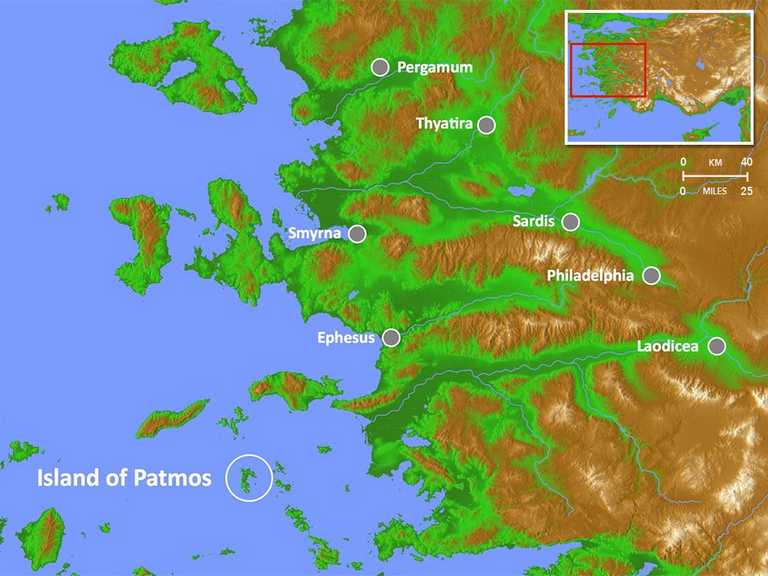 Revelation was written as a letter to be circulated among the Christian
churches at seven important cities in Asia Minor: Ephesus, Smyrna, Pergamum,
Thyatira, Sardis, Philadelphia, and Laodicea (Revelation 1:9-11).
Revelation was written as a letter to be circulated among the Christian
churches at seven important cities in Asia Minor: Ephesus, Smyrna, Pergamum,
Thyatira, Sardis, Philadelphia, and Laodicea (Revelation 1:9-11).
Asia Minor was a region of the Roman Empire that is now the western part of the country of Turkey. Patmos is a small, rocky island off its coast. The map at right shows these sites at the time Revelation was written. There had been several waves of persecutions of Christians by Roman authorities. The vision John received offered encouragement to persecuted Christians and assurance that God was still in control. The forces of evil, particularly the Roman Empire, would eventually be utterly destroyed by God. Revelation offers comfort and encouragement to Christians of all ages that God is firmly in control. When the time is right, the forces of evil that seem to dominate our world will be utterly destroyed, and God's eternal kingdom will come into its fulfillment. In particular, John's vision offered encouragement and comfort to the persecuted Christians of Asia Minor that their suffering was not in vain. God would surely triumph and destroy the evil Roman Empire that was the source of their persecution. |
InterpretationRevelation often seems bizarre and incomprehensible. But understanding the apocalyptic genre, the history of the early Christians, the persecutions they faced, their fears, and the issues they debated makes it much clearer. Many of the images and symbols parallel those in Old Testament books such as Daniel. Others allude to people, places and events that were very familiar to the first century Christians of Asia Minor. Extensive research in these areas has given Bible scholars a good understanding of what John's visions were intended to mean and how they would have been understood by their original audience in Asia Minor.Even so, many different shades of interpretation are possible, and there is still considerable debate about the meaning of some of the symbols and images. Many of the scenes in Revelation convey a strong sense of God's infinite power and glory, and that may be its most important message of all. Prediction of Current and Future EventsOver the centuries, there have been countless fanciful interpretations of Revelation. Many fascinating books, essays, and sermons have tried to equate the cataclysmic images in Revelation to world events and to predict when or how the "end times" would come. But the fact that none of those countless predictions has come true demonstrates the futility of trying to predict things known only to God (Matthew 24:36-50, Luke 12:40, 1 Thessalonians 5:1-3).In recent years, some people have understood the allusions in Revelation as references to modern events and modern nations, particularly Israel and the United States. However, most Bible scholars say the symbols in Revelation refer to events and places familiar to its intended audience - the first century Christians in Asia Minor. The book, itself, states that its message is directed at the first century Christians in Asia Minor, and that the events it describes would happen "soon" (Revelation 1: 1-4, 1:9-11, 22:10). Revelation in Popular CultureThe book of Revelation, the Rapture and related Bible prophecies have spawned a whole industry in recent years. Hal Lindsey's 1970 book The Late Great Planet Earth and the Left Behind series by Tim LaHaye and Jerry B. Jenkins have been at the forefront. Besides the many books, there are websites, TV evangelists, lecture series, movies and videos. Some of these feature imaginative and vivid embellishments of Bible prophecies mingled with contemporary political and social theories. Most of these works go well beyond anything revealed in the Bible and are properly classified as fiction - not as Bible prophecy.Revelation as PropagandaSome have tried to turn Revelation into propaganda by associating its evil symbols with various modern nations, churches, religious leaders, political leaders or other people. However, such interpretations seem to be based on little more than prejudice and hatred. The evil symbols in Revelation almost certainly referred to the ancient Roman Empire and its emperors. |
SynopsisThis section gives a brief synopsis of each section of Revelation and an interpretation based on the best mainstream reference materials available. |
Introduction (1:1-20)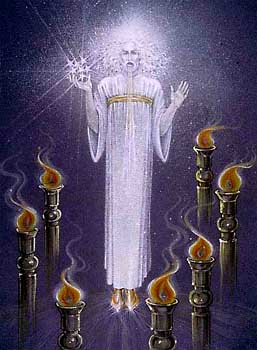 John introduces Revelation as a letter to the seven Christian churches of
Asia Minor. He states that it is a revelation given to him by Jesus Christ
through an angel. One day, John falls into a kind of ecstatic state and
experiences the vision he records in Revelation. He hears a voice and turns
to see a vision of seven golden lampstands. In the midst of the lampstands
is "One like the Son of Man" with white hair, eyes like fire,
and a voice like rushing water. A two-edged sword is coming out of his mouth.
John introduces Revelation as a letter to the seven Christian churches of
Asia Minor. He states that it is a revelation given to him by Jesus Christ
through an angel. One day, John falls into a kind of ecstatic state and
experiences the vision he records in Revelation. He hears a voice and turns
to see a vision of seven golden lampstands. In the midst of the lampstands
is "One like the Son of Man" with white hair, eyes like fire,
and a voice like rushing water. A two-edged sword is coming out of his mouth.
Interpretation: The One like the Son of Man is the risen Christ, in all His heavenly glory and power. The seven gold lampstands are the seven churches of Asia Minor. The seven stars in Christ's right hand are the seven angels of those churches (Revelation 1:20). The sharp, two-edged sword coming from His mouth is the word of God (Isaiah 11:4, 49:2, Hebrews 4:12). |
The Seven Letters (2:1 - 3:22)The One like a Son of Man dictates seven messages for John to send to the seven churches in Asia Minor. A letter of several paragraphs is addressed to each of the seven churches. Each message praises the church community for its strengths and urges community members to correct their weaknesses. |
A Vision of Heaven (4:1 - 5:14)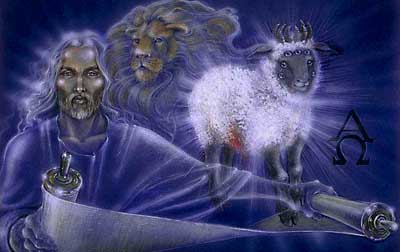 John has a vision of an open door to heaven. He sees the throne of God and
the heavenly court. He sees a scroll with seven seals in the right hand
of God, but no one is found worthy to open it except a lamb.
John has a vision of an open door to heaven. He sees the throne of God and
the heavenly court. He sees a scroll with seven seals in the right hand
of God, but no one is found worthy to open it except a lamb.
Interpretation: The "lamb" is Jesus. Lambs were routinely sacrificed in the Jewish temple for atonement (reconciliation) with God. God accepted the death of the animal as a substitute for the death that a sinner actually deserved. Jesus was metaphorically called "Lamb of God" because he gave his life as a sacrifice for all sinners (John 1:25-29, 1 Peter 1:18-19). |
Opening of the Seven Seals (6:1 - 8:5)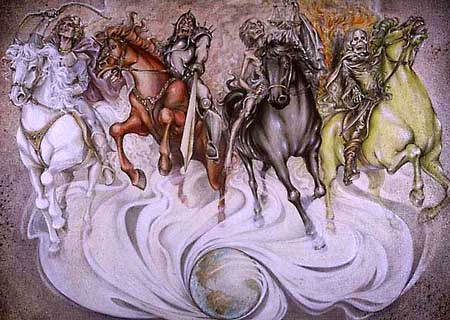 Opening of the Seven Seals (6:1 - 8:5). The Lamb opens the seven seals of
the scroll. As each is opened, it reveals one aspect of human suffering
or human destiny:
Opening of the Seven Seals (6:1 - 8:5). The Lamb opens the seven seals of
the scroll. As each is opened, it reveals one aspect of human suffering
or human destiny:
|
The Seven Trumpets (8:6 - 11:19)As each of the seven trumpets is blown, a plague is unleashed upon the earth.
Interpretation: These plagues are similar to the Plagues of Egypt in Exodus 7 - 12. The plagues in Exodus served as a warning to the Egyptian pharaoh to repent. These plagues of partial destruction serve as a warning to the Roman Emperor Domitian to repent. They also foreshadow the total destruction to come later. |
The Woman, Dragon and Child (12:1-18)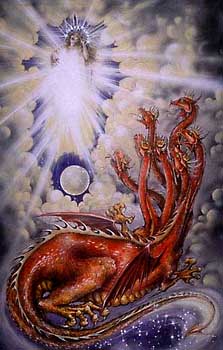 A woman about to give birth appears in the sky. A red dragon with 7 heads
and 10 horns also appears, waiting to devour the woman's child. The woman
gives birth, and she and the child escape. War breaks out in heaven. Michael
and his angels battle against the dragon. The dragon is thrown down to earth.
The dragon is angry and makes war against the faithful Christians of earth.
A woman about to give birth appears in the sky. A red dragon with 7 heads
and 10 horns also appears, waiting to devour the woman's child. The woman
gives birth, and she and the child escape. War breaks out in heaven. Michael
and his angels battle against the dragon. The dragon is thrown down to earth.
The dragon is angry and makes war against the faithful Christians of earth.
Interpretation: The woman represents Mary, Jesus' mother, and/or Israel, Jesus' birthplace. She gives birth to her son, Jesus. The dragon represents Satan (Revelation 12:9). |
The Beast from the Sea (13:1-10)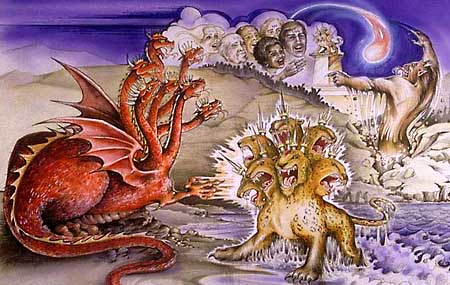 A beast with seven heads and ten horns emerges from the sea. It has a blasphemous
name on each head. It is like a leopard, but with feet like a bear and mouth
like a lion. The dragon gives it great power and authority over every tribe,
language and nation.
A beast with seven heads and ten horns emerges from the sea. It has a blasphemous
name on each head. It is like a leopard, but with feet like a bear and mouth
like a lion. The dragon gives it great power and authority over every tribe,
language and nation.
Interpretation: The seven heads, each with a "blasphemous name" represent the seven Roman emperors and the seven hills of Rome (Revelation 17:9-10). So, this beast represents the evil Roman Empire, which received its power and authority from Satan. |
The Beast from the Earth (13:11-18)Another beast comes up out of the earth. It has two horns like a lamb but speaks like a dragon. It deceives the inhabitants of earth. No one can buy or sell who does not bear the mark of the beast. One with wisdom can calculate the number of the beast, for it is the number of a person. Its number is six hundred sixty-six.Interpretation: There is some disagreement, but this beast most likely represents the Roman emperor Nero. The Hebrew language used letters to represent numbers. Taking Nero's Greek name (Neron Kaiser), writing it in equivalent Hebrew letters and adding up the value of the letters yields 666. The Christians of Jewish origin, who were familiar with Hebrew, would see this immediately. But the Roman authorities would not be able to figure it out. Nero, a fierce persecutor of Christians, had committed suicide in 68 A.D. But there was a persistent rumor that he was still alive. The healed wound in Revelation 13:3, 13:12 alludes to that rumor. The emperor's image was stamped on Roman coins, so no one could buy or sell without having the beast's image (Revelation 13:16-17). The dragon (Satan), the beast from the sea (the Roman Empire) and the beast from the earth (Emperor Nero) represent a sort of "unholy trinity" to mock the real Trinity of Father, Son and Holy Spirit. |
The Lamb and the 144,000 (14:1-5)John sees the Lamb standing on Mount Zion with the 144,000 sealed by the angel. They have been redeemed from mankind as the first fruits for God and the Lamb.Interpretation: Mount Zion was the hill the temple at Jerusalem was built on. Here, it represents God's throne in heaven (Revelation 14:3). The 144,000 probably represent all the faithful Christians who will be martyred for their faith. |
The Three Angels (14:6-13)A first angel says, "Fear God and give him glory, for the hour of his judgment has come." A second angel says, "Fallen, fallen is Babylon the great! She has made all nations drink of the wine of the wrath of her fornication." A third angel says, "Those who worship the beast and its image, and receive a mark on their foreheads or on their hands, they will also drink the wine of God's wrath." (NRSV)Interpretation: These are warnings of God's impending judgment against the wicked. Babylon was a code name the early Christians used for the city of Rome, capital of the evil Roman Empire (see The Whore of Babylon, below). "Those who worship the beast and its image" are those who worship the Roman Emperor instead of God. |
The Harvest of the Earth (14:14-20)John sees One like the Son of Man reap the earth with a sharp sickle. The harvesting of the earth is compared to the harvesting of grapes in a vineyard. The grapes are thrown onto God's winepress of wrath to be trampled underfoot.Interpretation: This is another warning of God's impending judgment against the wicked. |
The Seven Bowls of God's Wrath (15:1 - 16:21)John sees seven angels with seven gold bowls filled with God's wrath. The angels pour out the bowls one at a time upon the earth.
Interpretation: This tells of God's final and total judgment against the Roman Empire. The Emperor and the people who worship him have sealed their fate by ignoring all warnings to repent. The great city (Rome) will be destroyed and its citizens killed. |
The Whore of Babylon (17:1-18)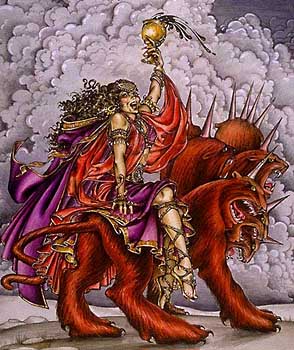 John sees a woman seated on a scarlet beast with seven heads and ten horns.
On her forehead is written, "Babylon the great, mother of whores and
of earth's abominations." (NRSV).
John sees a woman seated on a scarlet beast with seven heads and ten horns.
On her forehead is written, "Babylon the great, mother of whores and
of earth's abominations." (NRSV).Interpretation: The early Christians used "Babylon" as a code word for Rome. Babylon was an ancient city between the Tigris and Euphrates Rivers, and it was noted for its wickedness. In 587 B.C. the Babylonian army captured Jerusalem and took many Jews captive. Thus, Babylon held a special place of infamy in Jewish history. Similarly, the Roman army attacked Jerusalem in 70 A.D., about 25 years before Revelation was written. The holy city and the temple were destroyed and most of the people were massacred. To the early Christians, Rome was the new "Babylon," the source of all evil. In Revelation 17:18, John makes it clear that the "whore of Babylon" was the ancient capital city of the Roman Empire. |
The Fall of Babylon (18:1-24)An angel announces that the fall of Babylon is imminent, and warns the faithful to depart the city to escape the destruction. Those who have profited from their relationship with Babylon lament her passing.Interpretation: As before, Babylon represents the ancient city of Rome. |
Rejoicing in Heaven (19:1-10)A great multitude in heaven sing a song of praise to God, who has pronounced righteous judgment against the whore of Babylon and avenged the blood of His servants.Interpretation: This is a victory song and assurance to the persecuted Christians of Asia Minor that God is firmly in control and everything will go according to His plan, in His time. It is also a reminder to Christians not to take vengeance themselves (Revelation 19:2, Deuteronomy 32:35-41, Romans 12:19-21). |
The Rider on the White Horse (19:11-21)The heavens are opened again, and John sees a rider on a white horse. Its rider is called "Faithful and True." His robe is inscribed with the words, "King of kings and Lord of lords." The beast from the sea and the beast from the earth make war against the rider on the white horse. They are captured and thrown into the fiery pool of burning sulfur. Their followers are killed.Interpretation: The rider on the white horse is Christ. The Roman Empire and its Emperors are defeated once and for all and are utterly destroyed. The victory is accomplished by God and Christ alone; human armies do not participate. Christ did "conquer" the Roman Empire without help from human armies and without the cataclysmic destruction we might infer from John's vision. The Roman Emperor Constantine issued the Edict of Milan in 313 A.D. which ended all persecution of Christians and returned confiscated Church property. In 391 A.D., Christianity became the official state religion of the Empire. |
Satan is Bound for a Thousand Years (20:1-10)John sees an angel seize the dragon, Satan, tie it up in chains and throw it into the abyss. The dragon is confined there for a thousand years so it can no longer lead the nations astray. After a thousand years, Satan is released to again deceive the nations of earth for a short time. Then Satan is thrown into the pool of fire and sulfur with the other two beasts to be tormented day and night forever and ever.Interpretation: This thousand year period is known as the "millennium," and it has been interpreted many different ways. One common interpretation is that the millennium is the present age - the binding of Satan has already been accomplished by Christ, and His work is carried on by the faithful within the Church. There are also two other common interpretations:
|
The Judgment of the Dead (20:11-15)John sees all the dead standing before a great white throne. All are judged according to their works as recorded in the "book of life." Anyone whose name is not found in the book of life is thrown into the lake of fire. Death and Hades are also thrown into the lake of fire.Interpretation: All people who have ever lived will face a final judgment (John 5:25-29, 1 Corinthians 15:20-29, Hebrews 9:27-28). Death is defeated, and there will be no more death after this. |
The New Heaven and the New Earth (21:1-8)John sees a new heaven and earth; the old order is no more. A new holy city, the new Jerusalem, comes down from heaven. God will now dwell among people. "He will wipe every tear from their eyes. Death will be no more; mourning and crying and pain will be no more, for the first things have passed away." (NRSV)Interpretation: With evil destroyed and the earth purified, God will now dwell among the faithful whose names are written in the book of life. |
The New Jerusalem (21:9 - 22:5)The new holy city is described in all its splendor. There is no need for a temple because God and Christ will be there.Interpretation: All the effects of sin have been erased from earth. The new state of the earth is a paradise like the Garden of Eden, and God will dwell among the people. |
Epilogue (22:6-21)Christ assures John that He is coming soon. He says, "I am the Alpha and the Omega, the first and the last, the beginning and the end," and "Surely I am coming soon!"Interpretation: Alpha and omega are the first and last letters of the Greek alphabet, the original language of Revelation. So, Christ is eternal, the beginning and end of everything. The Christians of Asia Minor, and Christians of all times, are assured of their eternal reward for their faithfulness. Even though things may seem hopeless, God will make everything right in the end! |
References for In-Depth StudyCharles T. Chapman, Jr., The Message of the Book of Revelation, The Liturgical Press, Collegeville, Minnesota, 1995. A readily available paperback by an Episcopal priest that gives a verse-by-verse explanation of Revelation based on a hundred years of scholarly research. G. B. Caird, The Revelation of St. John the Divine, Harper's New Testament Commentaries, Henry Chadwick, ed., Harper & Row Publishers, New York, 1966. A standard commentary on Revelation. R. H. Charles, The Revelation of St. John, The International Critical Commentary, Driver, Pummer and Briggs, eds., T. & T. Clark, Edinburgh, 1920. A standard commentary on Revelation. G. J. Wenham, et. al., New Bible Commentary, 21st Century Edition, Intervarsity Press, 1994. Commentary, interpretation and historical perspective on each book and each verse of the Bible. James L. Mays, ed., Harper's Bible Commentary, Harper, 1988. Commentary, interpretation and historical perspective on each book and each verse of the Bible. |